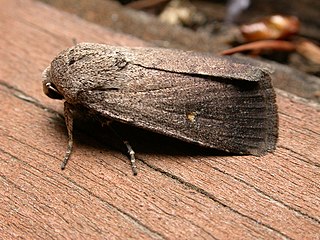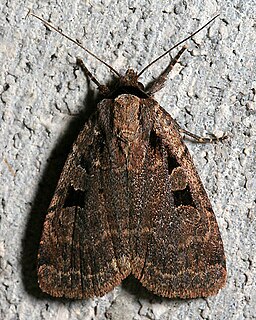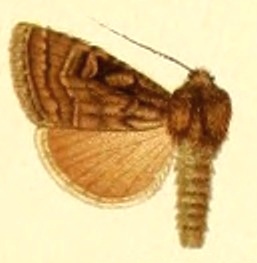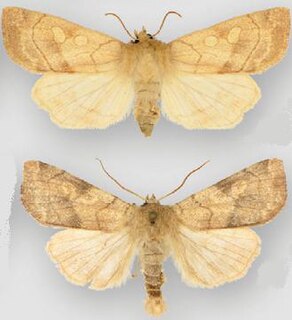
Xestia is a genus of noctuid moths. They are the type genus of the tribe Xestiini in subfamily Noctuinae, though some authors merge this tribe with the Noctuini. Species in this genus are commonly known as "clays", "darts" or "rustics", but such names are commonplace among Noctuidae. Xestia moths have a wide distribution, though they most prominently occur in the Holarctic.

Eugraphe is a genus of noctuid moths. They belong to the tribe Xestiini of the typical noctuid subfamily Noctuinae, though some do not separate this tribe and include the genus in the Noctuini. It is closely related to Anagnorisma, Coenophila and Eugnorisma, and as it seems most closely to the first of these. The geographic range is Palearctic, north of the Alpides but including the Caucasus, and between the Arctic and the arid lands of Central Asia.

Proteuxoa is a genus of moths of the family Noctuidae. The genus was erected by George Hampson in 1903.

The Two-Spot Dart is a moth of the family Noctuidae. It is found from coast to coast across central and southern Canada, and in the northern United States, south along the Appalachians to western North Carolina and Tennessee. There are a few scattered records along the Rocky Mountains from south-western Montana to south-eastern Arizona.
Lycophotia phyllophora, the lycophotia moth, is a moth of the family Noctuidae. It is found across southern and central Canada from New Brunswick and Nova Scotia to western Ontario, and in the northern United States from Maine to Minnesota, south to Ohio, and along the Appalachians to western North Carolina.

Euxoa adumbrata, the sordid dart, is a moth of the family Noctuidae. The species was first described by Eduard Friedrich Eversmann in 1842. In North America it is found across northern Canada from Quebec to western Alaska, south to the northern parts of the United States, and in the mountains to Colorado. It is also found in Greenland, the coastal areas of Scandinavia and the Ural. It was recently recorded from Denmark, although this includes Euxoa lidia, which some authors regard to be a valid species.

Rhyacia quadrangula is a moth of the family Noctuidae. It is found in Iceland, central Asia, the Pamir Mountains, Greenland as well as Canada and the north-western United States.

Goniographa is a genus of noctuid moths. They belong to the tribe Xestiini of the typical noctuid subfamily Noctuinae, though some do not separate this tribe and include the genus in the Noctuini.

Goniographa marcida is a moth of the family Noctuidae. It is found endemic to the Kopet-Dagh mountain system in Turkmenistan and Iran.
Goniographa decussa is a moth of the family Noctuidae. It is found in the western Tien-Shan Mountains.
Goniographa discussa is a moth of the family Noctuidae. It is found from the Zeravshan Mountains and Hissar Mountains through the western Pamirs to north-eastern Afghanistan (Badakhshan).
Goniographa shchetkini is a moth of the family Noctuidae. It is only known from a single location near the Liangar Glacier.

Goniographa funkei is a moth of the family Noctuidae. It is found in the western Tien-Shan Mountains, the Hissar Mountains and the western parts of the Pamir massif.
Goniographa metafunkei is a moth of the family Noctuidae. It has a strictly limited distribution in the western part of the Tien-Shan Mountains and the Alai Mountains.
Goniographa naumanni is a moth of the family Noctuidae. It is confined to the Hissar Mountains, the western Pamirs and the north-eastern territories of Afghanistan.
Xestia ornata is a moth of the family Noctuidae. It is found from the northern Tien-Shan Mountains through the Pamirs and Hissar-Darwaz system to eastern Afghanistan (Nuristan).
Xestia hypographa is a moth of the family Noctuidae. It is only known from the north-western part of the Tien-Shan Mountains.

The pale enargia or aspen twoleaf tier is a moth of the family Noctuidae. It has a boreal-transcontinental distribution, occurring across the Canadian boreal plain and then southward through the western cordillera at higher elevations, where it is presumably limited by the availability of trembling aspen and possibly other poplars. Records range from northernmost British Columbia and south-western Northwest Territories east to New Brunswick. It has also been reported from Nova Scotia, Ohio and New York. In the western United States it is known from western Montana, Idaho, Washington, Oregon, Nevada, Utah, Wyoming, western Colorado, New Mexico, and Arizona. There are no records from the Rocky Mountain front ranges of Colorado, where it would be expected to be widespread if there is a continuous distribution southward into New Mexico and Arizona. The populations from west of the Rocky Mountains south to New Mexico and Arizona may represent a distinct species.
Proteuxoa goniographa is a moth of the family Noctuidae. It is found in Queensland.

Eugraphe sigma is a moth of the family Noctuidae. It is found from most of Europe to the Ural, Siberia, Transcaucasia, Armenia and Korea.










